Disconnect the terminals(A) from battery and remove the battery.
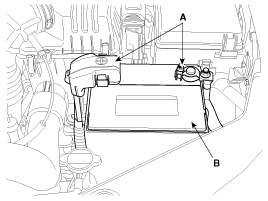
Engine removal is not required for this procedure.
Use Fender cover to avoid damaging painted surfaces.
To avoid damaging the cylinder head, wait until the engine coolant temperature drops below normal temperature before removing it.
When handling a metal gasket, take care not to fold the gasket or damage the contact surface of the gasket.
To avoid damage, unplug the wiring connectors carefully while holding the connector portion.
Mark all wiring and hoses to avoid misconnection.
Turn the crankshaft pulley so that the No. 1 piston is at top dead center.
Disconnect the terminals(A) from battery and remove the battery.

Remove the engine cover(A) and engine center cover(B).
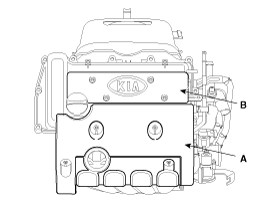
Remove the radiator cap to speed draining.
Remove the under cover(A).
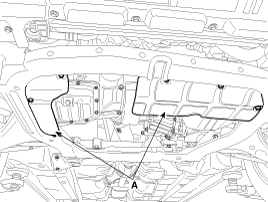
Loosen the radiator drain plug(A) and drain engine coolant.
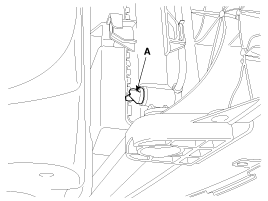
Remove the front bumper upper cover(A) and the air duct(B).
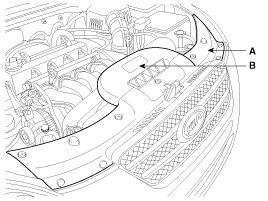
Remove the intake air hose(A) and air cleaner assembly.
Disconnect the breather hose(B) from intake air hose(A).
Disconnect the intake air hose(A) and accelerator cable(C).
Disconnect the PCM connector(D).
Remove the air cleaner assembly(E).
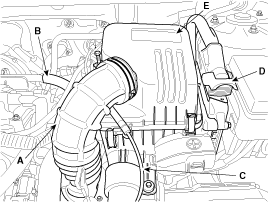
Remove the battery tray(A) and disconnect the front connector(B).
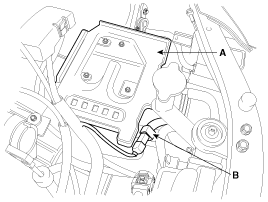
Remove the upper radiator hose(A) and lower radiator hose(B).
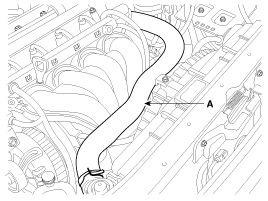
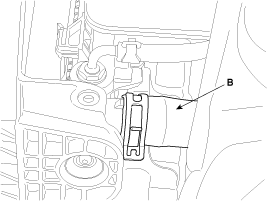
Loosen the water pump mounting bolt and the drive idler mounting bolt.
Loosen the alternator tension adjusting bolt(A) to loosen tension.
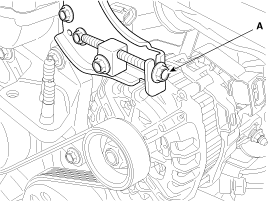
Remove the alternator drive belt(A).
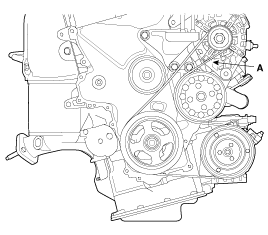
Remove the alternator(A). (Refer to Alternator in EE Group).
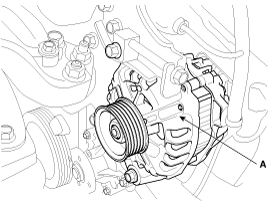
Remove the RH front wheel.
Remove the engine mounting bracket(A) and the ground line(B).
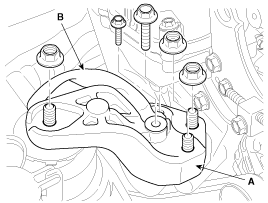
Support the engine with a jack not to be tilted.
Do not support the engine - transaxle - subframe assembly with the hangers.
Remove the alternator bracket.
Remove the engine support bracket(A).
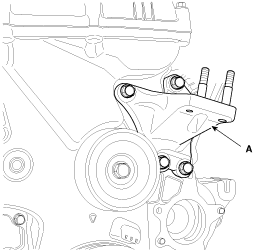
Remove the water pump pulley(A).
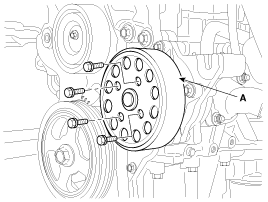
Remove the water pump(A).
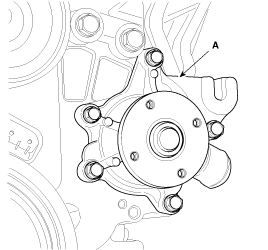
Remove the drive belt idler(A).
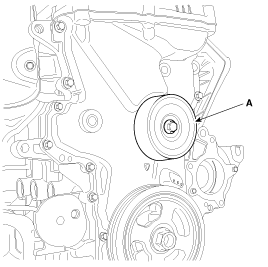
Disconnect the ignition coil connector(A) and the breather hose(B).
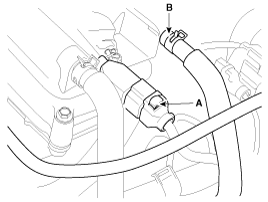
Disconnect the positive crankcase ventilation(PCV) hose(A), and PCSV hose(B).
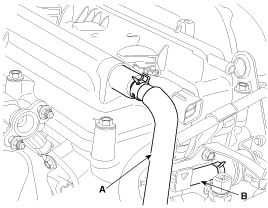
Remove the engine wire harness connectors and wire harness clamps from cylinder head and the intake manifold.
Disconnect the front(A) and the rear(B) oxygen sensor connector.
Disconnect the ignition coil condenser connector(C) and the purge control solenoid valve(PCSV) connector(D).
Disconnect the throttle position sensor(TPS) connectoe(E).
Disconnect the engine coolant temperature sensor(ECTS) connector(F) and the water hose(G).
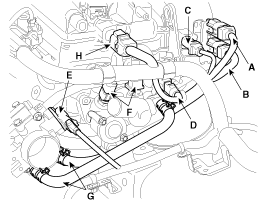
Remove the ignition coil(A).
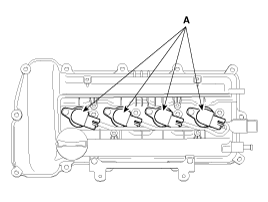
Remove the cylinder head cover bolts(A).
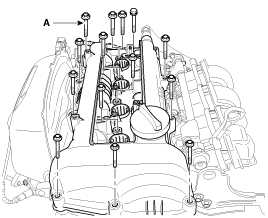
Remove the cylinder head cover(A) with its gasket(B).
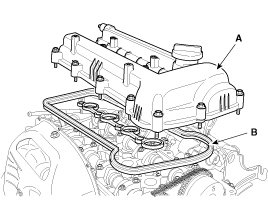
Remove side cover.
Turn the crankshaft pulley clockwise, and align its groove with the timing mark of the timing chain cover.
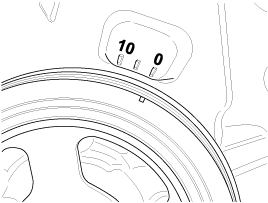
Remove the crankshaft bolt(B) and crankshaft pulley(A).
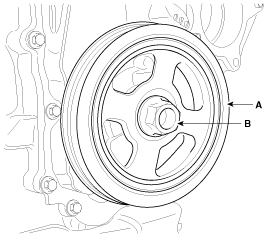
Remove the timing chain cover(A).
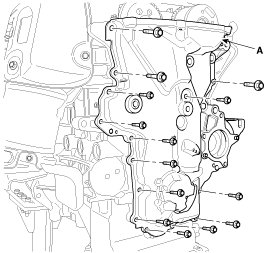
Align the timing marks of the camshaft sprocket with the upper surface of the cylinder head to make No.1 cylinder be positioned at TDC.
Check the dowel pin of the crankshaft for facing upside of the engine at this monent.
Put paint marks on the timing chain links(3places) that meet with the timing marks of the camshaft sprockets(In, Ex : 2) and the crankshaft sprocket.
Remove the hydraulic tensioner(A).
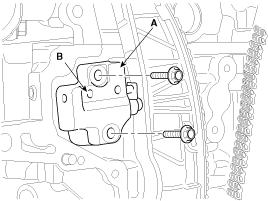
Remove the timing chain tensioner arm(A) and guide(B).
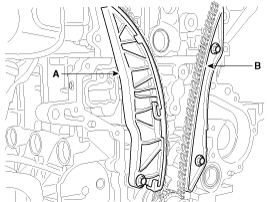
Remove the timing chain(A).
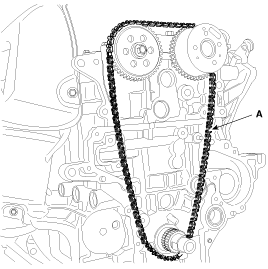
Remove the camshaft bearing caps(A) with the order below.
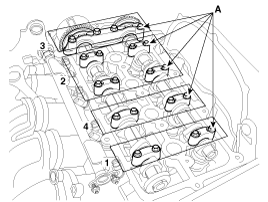
Remove the injector connectors(A) and the harness bracket(B).
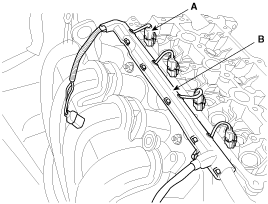
Remove the delivery pipe(A).
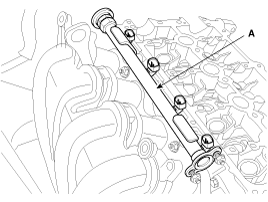
Remove the exhaust manifold assembly.
Remove the intake manifold module assembly.
Disconnect the camshaft position sensor(CMP) connector(A) and remove the purge control solenoid valve(PCSV) bracket(B) and the module hanger bracket(C).
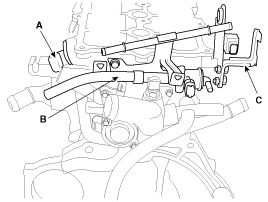
Remove the water temperature control assembly and the oil control valve(OCV).
Remove the cylinder head bolts, then remove the cylinder head.
Uniformly loosen and remove the 10 cylinder head bolts, in several passes, in the sequence shown.
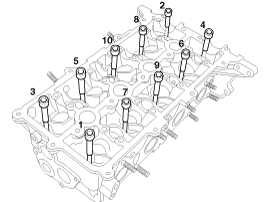
Head warpage or cracking could result from removing bolts in an incorrect order.
Lift the cylinder head from the cylinder block and put the cylinder head on wooden blocks.
Be careful not to damage the contact surfaces of the cylinder head and cylinder block.
Thoroughly clean all parts to be assembled.
Always use a new cylinder head and manifold gasket.
Always use a new cylinder head bolt.
The cylinder head gasket is a metal gasket. Take care not to bend it.
Rotate the crankshaft, set the No.1 piston at TDC.
Install the cylinder head assembly.
Before installing, remove the hardened sealant from the cylinder block and cylinder head surface.
Before installing the cylinder head gasket, apply sealant on the upper surface of the cylinder block and reassemble the gasket within five minutes.
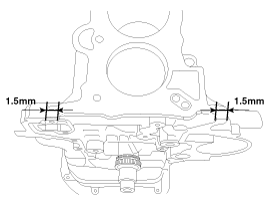
Refer to the illustration for applying sealant.
Width: 2.0 ~ 3.0mm(0.0787~0.1181in.)
Position: 1.0 ~ 1.5mm(0.0394~0.0591in.)
Specification: Three bond 1217H
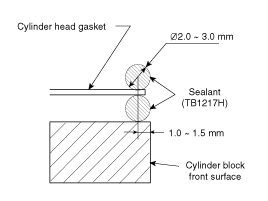
After installing the cylinder head gasket on the cylinder block, apply sealant on the upper surface of the cylinder head gasket and reassemble in five minutes.
Place the cylinder head carefully not to damage the gasket.
Install the cylinder head bolts with washers.
Tighten the 10 cylinder head bolts, in several passes, in the sequence shown.
Tightening torque :
17.7~21.6Nm (1.8~2.2kgf.m, 13.0~15.9lb-ft) + 90~95° + 100~105°
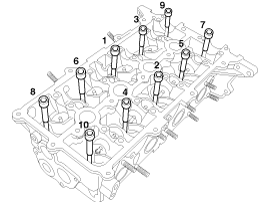
Always use new cylinder head bolts.
Install the oil control valve(OCV)(A).
Tightening torque :
9.8 ~ 11.8 N.m (1.0 ~ 1.2 kgf.m, 7.2 ~ 8.7 lb-ft)
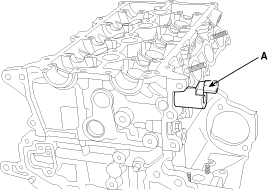
Tighten the mounting bolts for the water temperature control assembly(A) after installing the heater pipe(B).
Tightening torque :
M6 bolts : 9.8 ~ 11.8 N.m (1.0 ~ 1.2 kgf.m, 7.2 ~ 8.7 lb-ft)
M8 bolts : 18.6 ~ 23.5 N.m (1.9 ~ 2.4 kgf.m, 13.7 ~ 17.4 lb-ft)
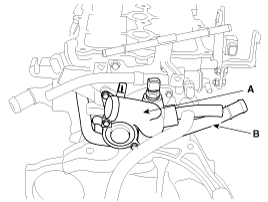
Connect the camshaft position sensor(CMP) connector(A) and install the purge control solenoid valve(PCSV) bracket(B) and the module hanger bracket(C).

Install the intake manifold module assembly.
Install the exhaust manifold assembly.
Install the delivery pipe assembly(A).

Install the injector connector(A) and harness bracket(B).

Install the camshafts.
Before installing, apply engine oil on journals.
Do not make oil flow down to the front side of the cylinder head.
After installing, check the valve clearance.
Install the camshaft bearing caps with the order below.
Tightening torque :
M6 bolts - 11.8 ~ 13.7N.m (1.2 ~ 1.4kgf.m, 8.7 ~ 10.1lb-ft)
M8 bolts - 18.6 ~ 22.6N.m (1.9 ~ 2.3kgf.m, 13.7 ~ 16.6lb-ft)
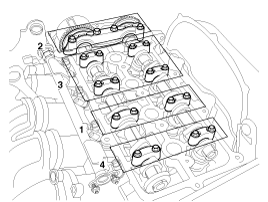
Align the timing marks of the camshaft sprocket with the upper sureface of the cylinder head to make No.1 cylinder be positioned at TDC.
Check the dowel pin of the crankshaft for facing upside of the engine at this monent.
Install the timing chain guide(A).
After installation of the chain guide(A), reassemble the timing chain(B).
Tightening torque :
9.8 ~ 11.8 N.m (1.0 ~ 1.2 kgf.m, 7.2 ~ 8.7 lb-ft)
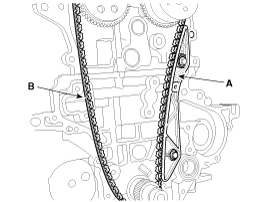
When installing a timing chain, align the timing marks on the sprockets with paint marks of the chain.
Order : Crankshaft sprocket → Timing chain guide → Intake camshaft sprocket → Exhaust camshaft sprocket.

Install the chain tensioner arm(A).
Tightening torque :
9.8 ~ 11.8 N.m (1.0 ~ 1.2 kgf.m, 7.2 ~ 8.7 lb-ft)
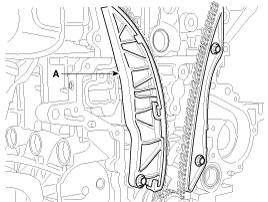
Fix the hydraulic tensioner(A) with a pin(B) before installing the tensioner(A) and remove the pin(B) after installing the tensioner(A).
Tightening torque :
9.8 ~ 11.8 N.m (1.0 ~ 1.2 kgf.m, 7.2 ~ 8.7 lb-ft)
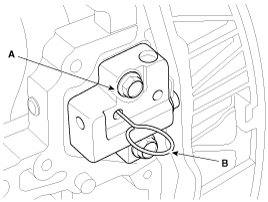
Recheck the top dead center(TDC) marks on the crankshaft and camshaft.
Install the timing chain cover(A).
Before installing, remove the hardened sealant from the cylinder block and ladder frame surface.
Apply the sealant, THREE BOND 1282B on the timing chain cover and the water pump of the oil pump and the sealant, THREE BOND 1217H on the rest parts.
Width: 3.5 ~ 4.5mm (0.1378~0.1772in.)
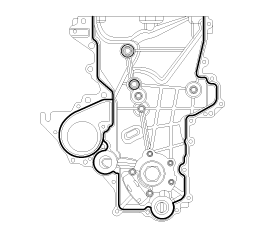
Remove oil or dust on the surface surely.
Apply the liquid gasket(1217H) on the surface between the cylinder head and the cylinder block and reassemble the cover(A) within five minutes.
Width: 3 ~ 5mm (0.1181~0.1969in.)
Align the dowel pin of the cylinder block and the holes of the oil pump.
Tightening torque :
12mm bolts - 18.6 ~ 23.5 N.m (1.9 ~ 2.4 kgf.m, 13.7 ~ 17.4 lb-ft)
10mm bolts - 9.8 ~ 11.8 N.m (1.0 ~ 1.2 kgf.m, 7.2 ~ 8.7 lb-ft)

After the installation, do not crank engine or apply pressure on the cover for half an hour.
Using the SST(09455-21200), reassemble the timing chain oil seal(A).
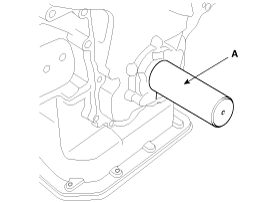
Install the crankshaft pulley(A).
Tightening torque :
127.5 ~ 137.3 N.m (13.0 ~ 14.0 kgf.m, 94.0 ~ 101.3 lb-ft)

When installing the pulley, remove the starter and fix the SST(09231-2B100).
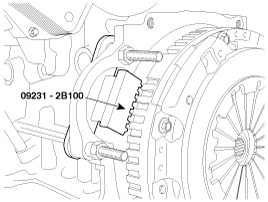
When installing the pulley, the groove on the pulley should be positioned outside.

Install side cover.
Tightening torque :
8.8 ~ 10.8 N.m (0.9 ~ 1.1 kgf.m, 6.5 ~ 8.0 lb-ft)
Install front right wheel and tire.
Before installing the cylinder head cover, remove oil, dust or hardened sealant from the timing chain cover and the cylinder head upper surface.
After applying the liquid gasket, THREE BOND 1217H on the cylinder head cover, reassemble the cover within five minutes.
Width : 2.0 ~ 2.5mm(0.0787~0.0984in.)
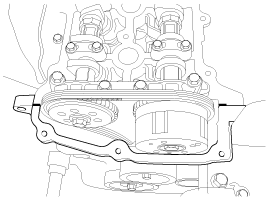
Install the cylinder head cover(A) with a new gasket(B).

Do not reuse the disassembled gasket.
Tighten the cylinder head cover bolts(A) with the order and steps.
Tightening torque :
1st step - 3.9 ~ 5.9 N.m (0.4 ~ 0.6 kgf.m, 2.9 ~ 4.3 lb-ft)
2nd step - 7.8 ~ 9.8 N.m (0.8 ~ 1.0 kgf.m, 5.8 ~ 7.2 lb-ft)
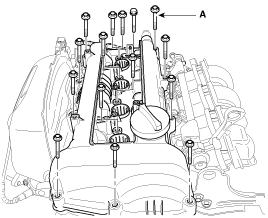
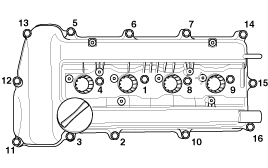
Install the ignition coils(A).
Tightening torque :
9.8 ~ 11.8 N.m (1.0 ~ 1.2 kgf.m, 7.2 ~ 8.7 lb-ft)

Install the positive crankcase ventilation(PCV) hose(A) and PCSV hose(B).

Connect the ignition coil connector(A) and the breather hose(B).

Install the drive belt idler(A).
Tightening torque :
42.2 ~ 53.9 N.m (4.3 ~ 5.5 kgf.m, 31.1 ~ 39.8 lb-ft)

Install the water pump(A) with a gasket.
Tighten bolts with the order below.
Tightening torque :
9.8 ~ 11.8 N.m (1.0 ~ 1.2 kgf.m, 7.2 ~ 8.7 lb-ft)
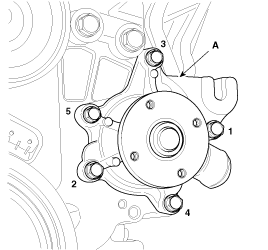
Install the water pump pulley(A).
Tightening torque :
9.8 ~ 11.8 N.m (1.0 ~ 1.2 kgf.m, 7.2 ~ 8.7 lb-ft)

Tighten the bolts diagonally.
Install the engine support bracket(A).
Tightening torque :
29.4 ~ 41.2 N.m (3.0 ~ 4.2 kgf.m, 21.7 ~ 30.4 lb-ft)

Install the alternator bracket(A).
Tightening torque :
19.6 ~ 26.5 N.m (2.0 ~ 2.7 kgf.m, 14.5 ~ 19.5 lb-ft)
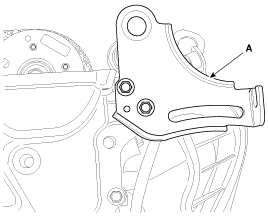
Supporting the engine with a jack, install the engine mounting bracket(A) and the ground line(B).
Tightening torque :
Bolt(C) - 58.8 ~ 83.4 N.m (6.0 ~ 8.5 kgf.m, 43.4 ~ 61.5 lb-ft)
Bolt, nuts(D,E) - 49.0 ~ 58.8 N.m (5.0 ~ 6.0 kgf.m, 36.2 ~ 43.4 lb-ft)
Bolt(F) - 9.8 ~ 11.8 N.m (1.0 ~ 1.2 kgf.m, 7.2 ~ 8.7 lb-ft)
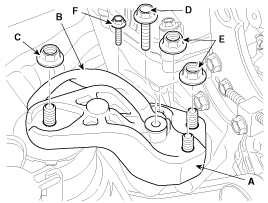
Install the alternator(A).
Tightening torque :
12mm bolts - 19.6 ~ 26.5 N.m (2.0 ~ 2.7 kgf.m, 14.5 ~ 19.5 lb-ft)
10mm bolts - 29.4 ~ 41.2 N.m (3.0 ~ 4.2 kgf.m, 21.7 ~ 30.4 lb-ft)

Install the drive belt(A).

Adjust tension by tightening the alternator tension adjust bolt(A).(Refer to Charging system in EE Group).
Tension
New belt: 882.6 ~ 980.7N (90 ~ 100kg, 198.4 ~ 220.5lb)
Used belt: 637.4 ~ 735.5N (65 ~ 75kg, 143.3 ~ 165.3lb)

Connect the connectors on the cylinder head and install the clamps.
Connect the front(A) and the rear(B) oxygen sensor connector.
Connect the ignition coil condenser connector(C) and the purge control solenoid valve(PCSV) conector(D).
Connect the throttle position sense (TPS) connector(E).
Connect the engine coolant temperature sensor (ECTS) connector(F) and the water hose(G).

Install the fuel hose(A) and the accelerator cable(B).
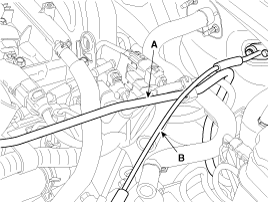
Connect the heater hose(A) and the brake booster hose(B).
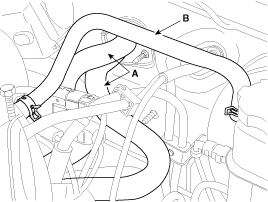
Connect the radiator upper hose(A) and lower hose(B).


Install the battery tray(A) and connect front connector(B).

Install the air cleaner assembly.
Tightening torque :
7.8 ~ 9.8 N.m (0.8 ~ 1.0 kgf.m, 5.8 ~ 7.2 lb-ft)
Connect the air cleaner hose(A) and bleeder hose(B).
Install the accelerator cable(A) to the air cleaner assembly.
Connect the opwer control module (PCM) connectors(D).

Install the air duct(A) and front bumper upper cover(B).
Tightening torque :
7.8 ~ 9.8Nm (0.8 ~ 1.0kgf.m, 5.8 ~ 7.2lb-ft)

Install the under cover(A).
Tightening torque :
8.8 ~ 10.8N.m (0.9 ~ 1.1kgf.m, 6.5 ~ 8.0lb-ft)

Install the engine center cover(B) and the engine cover(A).
Tightening torque :
7.8 ~ 11.8N.m (0.8 ~ 1.2kgf.m, 5.8 ~ 8.7lb-ft)

Install the cover surely before driving.
Install the battery(B) and connect the terminals(A).

Refill engine coolant and engine oil.
Start engine and check for leakage.
Recheck the level of engine oil and coolant.
Identify MLA(Mechanical lash adjuster), valves, valve springs as they are removed so that each item can be reinstalled in its original position.
Remove the MLAs(A).
When removing MLAs, mark all the MLAs for their rearrangement.
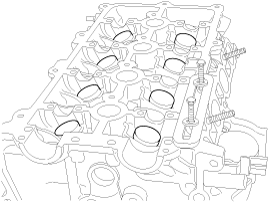
Remove the valves.
Using the SST (09222 - 3K000, 09222 - 3K100), compress the valve spring and remove the retainer lock.
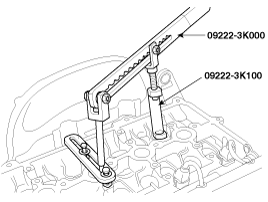
Remove the spring retainer.
Remove the valve spring.
Remove the valve.
Remove the valve stem seal.
Using a magnetic finger, remove the spring seat.
Do not reuse the valve stem seals.
Inspect for flatness.
Using a precision straight edge and feeler gauge, measure the surface the contacting the cylinder block and the manifolds for warpage.
Flatness of cylinder head gasket surface
Standard : Less than 0.05mm (0.0020in)
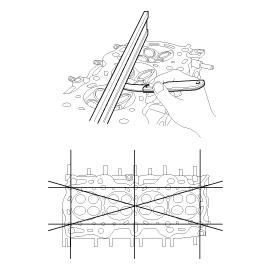
Inspect for cracks.
Check the combustion chamber, intake ports, exhaust ports and cylinder block surface for cracks. If cracked, replace the cylinder head.
Inspect the valve stems and valve guides.
Using a caliper gauge, measure the inner diameter of valve guide.
Valve guide inner diameter :
5.500 ~ 5.512mm (0.2165 ~ 0.2170in)
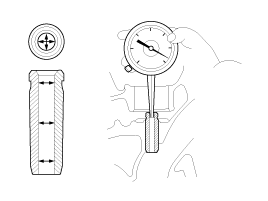
Using a micrometer, measure the outer diameter of valve stem.
Valve stem outer diameter
Intake : 5.465 ~ 5.480mm (0.2152 ~ 0.2157in)
Exhaust : 5.458 ~ 5.470mm (0.2149 ~ 0.2154in)
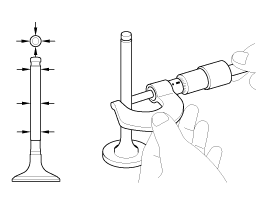
Subtract the valve stem outer diameter measurement from the valve guide inner diameter measurement.
Valve stem- to-guide clearance
Intake : 0.020 ~ 0.047mm (0.0008 ~ 0.0019in)
Exhaust : 0.030 ~ 0.054mm (0.0012 ~ 0.0021in)
If the clearance is greater than specification, replace the valve or the cylinder head.
Inspect the valves.
Check the valve is ground to the correct valve face angle.
Check that the surface of valve for wear.
If the valve face is worn, replace the valve.
Check the valve head margin thickness.
If the margin thickness is less than minimum, replace the valve.
Margin
Standard
Intake : 1.1mm (0.0433in)
Exhaust : 1.26mm (0.0496in)
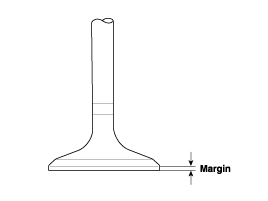
Check the length of valve.
Valve length
Standard
Intake : 93.15mm (3.6673 in)
Exhaust : 92.60mm (3.6457 in)
Check the surface of valve stem tip for wear.
If the valve stem tip is worn, replace the valve.
Inspect the valve seats.
Check the valve seat for evidence of overheating and improper contact with the valve face. If the valve seat is worn, replace the cylinder head.
Check the valve guide for wear. If the valve guide is worn, replace the cylinder head.
Inspect the valve springs.
Using a steel square, measure the out-of-square of valve spring.
Using a vernier calipers, measure the free length of valve spring.
Valve spring
Standard
Free height : 44mm (1.7323in)
Out of square : Less than 1.5˚
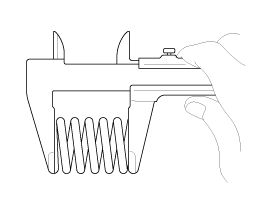
Inspect the cam height.
Using a micrometer, measure the cam height.
Cam height
Intake : 43.85mm (1.7264in)
Exhaust : 42.85mm (1.6870in)
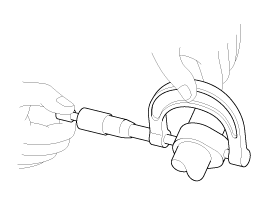
If the cam lobe height is less than specified, replace the camshaft.
Inspect the camshaft journal clearance.
Clean the bearing caps and camshaft journals.
Place the camshafts on the cylinder head.
Lay a strip of plastigage across each of the camshaft journal.
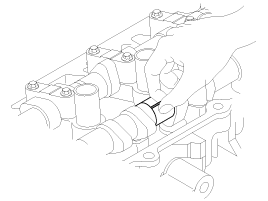
Install the bearing caps and tighten the bolts with specified torque.
Tightening torque :
M6 bolts : 11.8 ~ 13.7Nm (1.2 ~ 1.4kgf.m, 8.7 ~ 10.1lb-ft)
M8 bolts : 18.6 ~ 22.6Nm (1.9 ~ 2.3 kgf.m, 13.7 ~ 16.6lb-ft)
Do not turn the camshaft.
Remove the bearing caps.
Measure the plastigage at its widest point.
Bearing oil clearance
Standard : 0.020 ~ 0.057mm (0.0008 ~ 0.0022in)
Limit : 0.1mm ( 0.0039in)
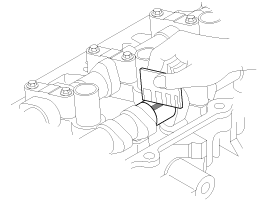
If the oil clearance is greater than specified, replace the camshaft. If necessary, replace the bearing caps and cylinder head as a set.
Inspect the camshaft end play.
Install the camshafts.
Using a dial indicator, measure the end play while moving the camshaft back and forth.
Camshaft end play
Standard : 0.1 ~ 0.2mm (0.0039 ~ 0.0079in)
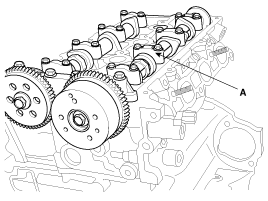
If the end play is greater than specified, replace the camshaft. If necessary, replace the bearing caps and cylinder head as a set.
Remove the camshafts.
Inspect the CVVT for smooth rotation.
Clamp the camshaft using a vise. Be careful not to damage the cam lobes and journals in the vise.
Check that the CVVT is locked by turning it clockwise or counterclockwise. It must not rotate.
Seal one of the two advance holes in the camshaft journal with tape.
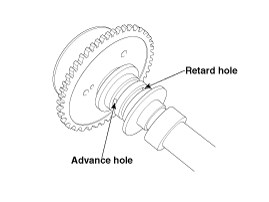
Apply approx. 150 kPa (1.5 kgf/㎠, 21 psi ) of compressed air into the unsealed advance hole to release the lock.
Cover the oil paths with a piece of cloth when applying compressed air to prevent oil from spraying.
With compressed air applied, rotate the CVVT into the advance direction (counterclockwise) within its phasing range and check that the CVVT turns smoothly.
CVVT phasing range
25˚±1˚ (from the most retarded position to the most advanced position)
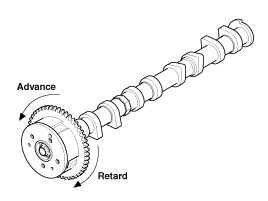
Rotate the CVVT into the most retarded position (clockwise) and then check that the CVVT is locked.
Thoroughly clean all parts to be assembled.
Before installing the parts, apply fresh engine oil to all sliding and rotating surface.
Replace oil seals with new ones.
Install the valves.
Install the spring seats.
Using the SST (09222 - 29000), push in a new oil seal.
Do not reuse old valve stem oil seals.
Incorrect installation of the seal could result in oil leakage past the valve guides.
Intake valve stem seals are different from exhaust ones in type. Do not reassembly ones in the other's places.
Install the valve, valve spring and spring retainer, after applying engine oil at the end of each valve.
When installing valve springs, the enamel coated side should face the valve spring retainer.
Using the SST(09222 - 3K000, 09222 - 3K100), compress the spring and install the retainer locks.
After installing the valves, ensure that the retainer locks are correctly in place before releasing the valve spring compressor.

When installing the SST, use the torque, 1.2kgf.m or less.
Lightly tap the end of each valve stem two or three times with the wooden handle of a hammer to ensure proper seating of the valve and retainer lock.
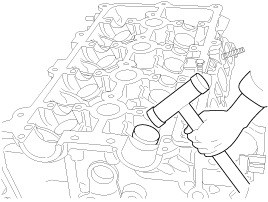
Install the MLA(Mechanical lash adjuster)s.
Check that the MLA rotates smoothly by hand.
All the MLAs should be installed in its original position.